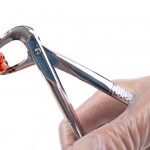
Teeth are extracted every day in dental surgeries throughout the world because of tooth decay and periodontal (gum) disease. Alveolar osteitis (dry socket) is a complication that can follow an extraction with estimates of its incidence ranging from <1-37.5%. Typically a blood clot is absent in the socket and the patients have pain in and around the site of the extraction, which increases over the first 1-3 days. The aim of this review was to assess the effects of local interventions used for the prevention and treatment of alveolar osteitis (dry socket).
The Cochrane Oral Health Group Trials Register, The Cochrane Central Register of Controlled Trials Medline and Embase databases were searched with no restrictions. Reference lists were searched and investigators and organisations contacted. Only Randomised controlled trials involving adults having permanent teeth extracted or developed dry socket post-extraction or were included. Any local intervention was considered. Studies reporting on systemic use of antibiotics or the use of surgical techniques for the management of dry socket were excluded.
- 21 trials (2570 participants) were included;
- 18 trials (2376 participants) for the prevention of dry socket,
- 3 studies (194 participants) for the treatment of dry socket.
- Only one studies was at low risk of bias 14 studies at unclear risk of bias and six at high risk.
- Compared to placebo, rinsing with chlorhexidine mouthrinses (0.12% and 0.2% concentrations) both before and after extraction(s) prevented approximately 42% of dry socket(s) with a RR of 0.58 (95% CI 0.43 to 0.78; P < 0.001) (four trials, 750 participants, moderate quality of evidence).
- The prevalence of dry socket varied from 1% to 5% in routine dental extractions to upwards of 30% in surgically extracted third molars.
- The number of patients needed to be treated (NNT) with (0.12% and 0.2%) chlorhexidine rinse to prevent one patient having dry socket was:-
- 232 (95% CI 176 to 417) at dry socket control prevalences of 1%,
- 47 (95% CI 35 to 84) at dry socket control prevalences of 5%,
- 8 (95% CI 6 to 14) at dry socket control prevalences of 30%.
- Compared to placebo, placing chlorhexidine gel (0.2%) after extractions prevented approximately 58% of dry socket(s) with a RR of 0.42 (95% CI 0.21 to 0.87; P = 0.02) (two trials, in 133 participants, moderate quality of evidence).
- The number of patients needed to be treated with chlorhexidine gel to prevent one patient having dry socket (NNT) was:-
- 173 (95% CI 127 to 770), at dry socket control prevalences of 1%,
- 35 (95% CI 25to 154) at dry socket control prevalences of 5%,
- 6 (95% CI 5 to 26) at dry socket control prevalences of 30%.
- A further 10 intrasocket interventions to prevent dry socket were each evaluated in single studies, and therefore there is insufficient evidence to determine their effects. Five interventions for the treatment of dry socket were evaluated in a total of three studies providing insufficient evidence to determine their effects.
The Authors concluded
Most tooth extractions are undertaken by dentists for a variety of reasons, however, all but three studies included in the present review included participants undergoing extraction of third molars, most of which were undertaken by oral surgeons. There is some evidence that rinsing with chlorhexidine (0.12% and 0.2%) or placing chlorhexidine gel (0.2%) in the sockets of extracted teeth, provides a benefit in preventing dry socket. There was insufficient evidence to determine the effects of the other 10 preventative interventions each evaluated in single studies. There was insufficient evidence to determine the effects of any of the interventions to treat dry socket.
The present review found some evidence for the association of minor adverse reactions with use of 0.12%, 0.2% and 2% chlorhexidine mouthrinses, though most studies were not designed to detect the presence of hypersensitivity reactions to mouthwash as part of the study protocol. No adverse events were reported in relation to the use of 0.2% chlorhexidine gel placed directly into a socket (though previous allergy to chlorhexidine was an exclusion criterion in these trials). In view of recent reports in the UK of two cases of serious adverse events associated with irrigation of dry socket with chlorhexidine mouthrinse, it is recommended that all members of the dental team prescribing chlorhexidine products are aware of the potential for both minor and serious adverse side effects.
Comment
Dry socket is a remains a troublesome problem and it is interesting to see the findings of this Cochrane review. Earlier this year we reported on another review by Yengopal (Dental Elf June 29th). The findings of that review are discussed in this Cochrane review. Yengopal used different inclusion criteria and reported that chlorhexidine had not been conclusively shown to be significantly better than placebo for reducing the incidence of alveolar osteitis (dry socket) in contrast to these findings.
Related to this review is the Cochrane review by Lodi et al on antibiotics to prevent complications of tooth extraction.
Links
Daly B, Sharif MO, Newton T, Jones K,Worthington HV. Local interventions for the management of alveolar osteitis (dry socket). Cochrane Database of Systematic Reviews 2012, Issue 12. Art. No.: CD006968. DOI: 10.1002/14651858.CD006968.pub2
Lodi G, Figini L, Sardella A, Carrassi A, Del Fabbro M, Furness S. Antibiotics to prevent complications following tooth extractions. Cochrane Database of Systematic Reviews 2012, Issue 11. Art. No.: CD003811. DOI: 10.1002/14651858.CD003811.pub2.

[…] Dental Elf -13th Dec 2012 – Moderate evidence that chlorhexidine rinse or gel provides a benef… […]
[…] Dental Elf – 13th Dec 2012 – Moderate evidence that chlorhexidine rinse or gel provides a be… […]
[…] Moderate evidence that chlorhexidine rinse or gel provides a benefit in preventing dry socket […]